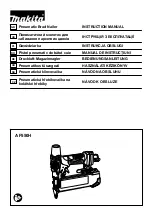
12
13
Setting the Air Pressure and Depth of
Drive
The amount of air pressure required will
depend on the size of the fastener and the
workpiece material.
Fig. 7
Set to middle of range
5. Begin testing the depth of drive by driv-
ing a test fastener into the same type of
workpiece material used for the actual
job using an air pressure of 90-95 psi.
1. Lay the tool on its side and point the
nose of the tool away from yourself and
others.
2. Disconnect the air supply from the tool
and remove fastener strip.
3. Set the depth of drive adjustment to the
middle of its range.
4. Reload fastener strip according to "In-
stalling Fastener Strips".
Reload Indicator
To indicate that the magazine is almost
empty of fasteners (about 4-6 left), the work-
piece contact will not compress, preventing
operation under usual pressure. Install more
fasteners to continue working.
Contact Actuation Operation
1. Grip the handle
fi
rmly.
2. Pull and hold the trigger.
3. Push the tool against the work surface,
compressing the workpiece contact to
drive the fastener. The tool will recoil
away from the workpiece as the fastener
is driven.
NOTE:
Contact Actuation will also work by
fi
rst compressing the workpiece contact, then
pulling the trigger.
REQUIRED DAILY TESTING
WARNING
To reduce the risk of injury to your-
self and others, test the tool before
beginning work each day or if the
tool is dropped, received a sharp
blow, been run over, etc. Complete
the following checklist IN ORDER. If
the tool does not work as it should,
contact a
MILWAUKEE
service facil-
ity immediately.
Always point tool away from yourself
and others.
1. Disconnect the air supply from the tool
and remove fastener strip.
2. Check all screws, bolts, nuts, and pins
on the tool. Any loose fasteners must be
tightened.
3. Press the pusher release button and
slide back the pusher assembly (to
override the Reload Indicator). Press the
workpiece contact against a workpiece.
It must move smoothly.
4. With the workpiece contact pressed
against the workpiece, pull the trigger.
It must move smoothly.
5. Connect the air supply (at 70 psi) to the
tool. DO NOT load a fastener strip.
6. Select the Single Sequential Actuation
Operation. Air must not leak from the
tool.
Without pulling the trigger, press the
workpiece contact against a workpiece.
The tool must not operate.
Holding the workpiece contact away
from the workpiece, pull and hold the
trigger for 5 seconds. The tool must not
operate.
Continue to pull and hold the trigger and
push the workpiece contact against a
workpiece. The tool must not operate.
Without pulling the trigger, press the
workpiece contact against a workpiece.
Pull the trigger. The tool must operate.
Release the trigger. The driver must
move up.
7. Select the Contact Actuation Opera-
tion.
Holding the workpiece contact away
from the workpiece, pull the trigger. The
tool must not operate.
Continue to pull and hold the trigger and
push the workpiece contact against a
workpiece. The tool must operate.
8. If all previous tests work properly, set the
tool for your work. Select the operation
and load fastener strips.
9. Set the depth of drive according to the
"Setting the Air Pressure and Depth of
Drive" section.
10. If all tests operate properly, the tool is
ready for use. Repeat these tests before
use each day or if the tool is dropped,
received a sharp blow, been run over,
jammed, etc.
6. Raise or lower the air pressure to
fi
nd the
lowest setting that will drive the fastener
consistently. Do not exceed 120 psi.
NOTE:
It may be possible to achieve the
desired depth with air pressure adjust-
ments alone. If
fi
ner adjustments are
needed, use the depth of drive adjust-
ment.
7. To
fi
ne-tune the depth of drive, discon-
nect the air supply and lay the tool on
its side and point the nose of the tool
away from yourself and others. Remove
fastener strip. Turn the depth selector
left or right to increase or decrease the
driving depth.
8. Reload fastener strip according to "In-
stalling Fastener Strips".
9. Drive a test fastener and repeat step 7
and 8 until desired depth is reached.
WARNING
Know what is behind your workpiece.
A fastener could travel through the
workpiece and out the other side,
striking a bystander and causing se-
rious injury. Lower the air pressure
and/or depth of drive to prevent the
fastener from being pushed all the
way through the workpiece.
WARNING
NEVER wedge or hold back the work-
piece contact mechanism during
operation of the tool. Never attempt
to clear a jammed workpiece contact
by grasping the discharge area of the
tool. Doing so could result in serious
injury.
To avoid serious injury, do not attempt
to prevent the recoil by holding the
tool too
fi
rmly against the work. Keep
face and body away from the tool.
During normal use, the tool will recoil
immediately after driving a fastener.
This is a normal function of the tool.
Restriction to the recoil can result
in a second fastener being driven
when the tool is in Contact Actuation
mode. Grip the handle
fi
rmly, let the
tool do the work, and do not place
a second hand on top of the tool or
near exhaust.


























